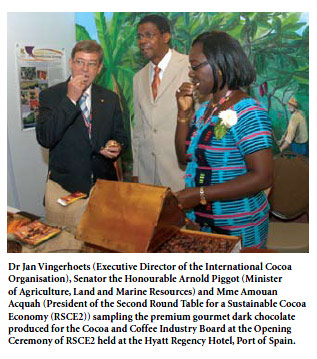Where's the Local Fine Chocolate?

It is legitimate to ask if Trinidad and Tobago is recognised as one of the world’s eight exclusive producers of fine or flavour cocoa, why it has not been a producer of fine chocolates. Two years ago, Prof John Spence, in a series of newspaper columns on reviving the cocoa industry, said it was high time for Trinidad and Tobago to seriously consider manufacturing premium quality chocolates from locally produced beans. Prof Spence had pointed to the increase in world demand for fine or flavour cocoa, especially as dark chocolates had been scientifically proven to be healthier and loaded with anti-oxidants (but require more beans to produce than milk chocolate).
According to Dr Darin Sukha, a Research Fellow at the Cocoa Research Unit (CRU), the response to this view is mixed, indicating the complexity of the issue.
“One school of thought states that producing countries should only focus on producing high quality cocoa for export in the most efficient manner possible and leave any further processing to be done at the traditional countries of export. Our current production volume is small and we have had no problem getting it sold at premium prices. We can double our present production levels without affecting price, so the incentive to produce chocolates has not been there,” he said.
The main premise for this argument is that any local value-added production will distract from the local cocoa production task at hand and will potentially divert valuable cocoa production to less lucrative local enterprises.
“The other school of thought states that there are potentially lucrative local markets for a wide range of valueadded products made from otherwise discarded primary cocoa processing by-products and lower grade fermented and dried cocoa beans. This parallel processing can utilise both lower grade beans and dedicated local first-grade cocoa bean production to create a range of value-added products for local and international consumption,” he said.
As suggested by Prof Spence, these markets can be explored and developed by cocoa farmers themselves at the cottage industry level and there is long-term potential for an established secondary cocoa processing industry.
The answer to whether it is feasible to take the plunge and produce dark chocolate lies in another equally complex question. Is there enough cocoa production locally to serve both lucrative bean export and chocolate production?
Sukha feels that in the past five years there has been a discernible change in the attitude toward rebuilding and revitalising local cocoa production.
“I am seeing the Cocoa and Coffee Industry Board (CCIB) and the Ministry of Agriculture of Agriculture, Land and Marine Resources (MALMR) with the CRU and other stake holders working together in a concerted effort to promote cocoa, increase cocoa production and make cocoa production more economically viable. What we need now is cheaper labour and research into labour-saving devices to make cocoa production less labour intensive,” he said.
 Cocoa production issues aside, on the international market, there are fine examples of exquisite chocolates using local Trinitario beans, branded especially to recognise their origins. The San Juan Estate in Gran Couva supplies beans for the European gourmet Valrhona chocolates, with one of its brands being called Gran Couva. Cocoa production issues aside, on the international market, there are fine examples of exquisite chocolates using local Trinitario beans, branded especially to recognise their origins. The San Juan Estate in Gran Couva supplies beans for the European gourmet Valrhona chocolates, with one of its brands being called Gran Couva.
In reality, according to Sukha, “chocolate production has always been a very skilled task, requiring extensive capital outlay for machinery that was not small scale… Only recently has small scale machinery become available so that the capital risk in entering into chocolate production has decreased.”
He has observed more people venturing into “chocolate and cocoa value-added products locally,” but he cautions that the quality of these products must be high to compete with what is already out there. “I am only now seeing some attention being paid to high quality and this is as a result of increased consumer awareness about quality issues.”
Another option for local chocolate production was successfully explored at the recent Second Roundtable for a Sustainable Cocoa Economy (RSCE2). For the RSCE2 meeting, the CCIB partnered with the Guittard Chocolate Company of California, USA, to produce a premium gourmet dark chocolate bar from 100 percent Trinitario beans from two (La Louisa Estate in Tamana and La Maraquita Estate in Gran Couva) of four cocoa estates (two in Moruga) owned by Lawrence Duprey and managed by Prism Agri Estates Co Ltd.
By entering into an exclusive contractual processing arrangement with an established dark or gourmet chocolate producer capable of handling small batches of beans, this option overcomes the prohibitive start-up costs and stringent quality criteria in setting up a chocolate manufacturing plant locally. This also allows low-risk testing of the local and export market for such a product until the critical mass and demand for the product are established.
With the urgency to diversify the economy, and add value to our primary production, and the evidence available that cocoa and fine chocolates are still in demand, The UWI has a crucial role to play. Sukha concluded that, “the CRU and UWI can facilitate in this drive to add value to cocoa production by partnering with entrepreneurs in research applied to chocolate formulation, product development and production, quality assessment as well as marketing.”
|





